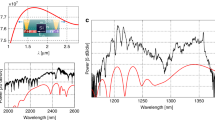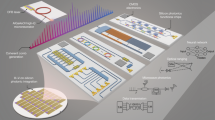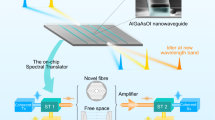Abstract
To meet the increasing demand for higher capacity in optical communications, signal transmission at higher modulation rates and over a broader wavelength range will be required. Signal degradation in the optical channel caused by dispersion, nonlinearity and noise becomes a critical issue as data rates increase. Thus, it is highly desirable to develop broadband, high-speed regeneration devices1. Recent advances in silicon-on-insulator photonic devices offer the potential for highly integrated, robust opto–electronic architectures, and optical processes such as amplification2,3,4, wavelength conversion5,6,7 and amplitude modulation8,9 have already been demonstrated in such structures. In this work, we demonstrate two regeneration schemes using low-power four-wave mixing in a silicon nanowaveguide and compensate for the effects of poor extinction ratio, dispersive broadening and timing jitter. This capability further expands the range of optical functions that can be incorporated into silicon-compatible photonic devices offering a broadband and integrated solution for regeneration.
This is a preview of subscription content, access via your institution
Access options
Subscribe to this journal
Receive 12 print issues and online access
$209.00 per year
only $17.42 per issue
Buy this article
- Purchase on Springer Link
- Instant access to full article PDF
Prices may be subject to local taxes which are calculated during checkout




Similar content being viewed by others
References
Leclerc, O. et al. Optical regeneration at 40 Gb/s and beyond. J. Lightwave Technol. 12, 2779–2790 (2003).
Claps, R., Dimitropoulos, D., Raghunathan, V., Han, Y. & Jalali, B. Observation of stimulated Raman amplification in silicon waveguides. Opt. Express 11, 1731–1739 (2003).
Espinola, R. L., Dadap, J. I., Osgood, R. M. Jr, McNab, S. J. & Vlasov, Y. A. Raman amplification in ultrasmall silicon-on-insulator wire waveguides. Opt. Express 12, 3713–3718 (2004).
Foster, M. A. et al. Broad-band optical parametric gain on a silicon photonic chip. Nature 441, 960–963 (2006).
Fukada, H. et al. Four-wave mixing in silicon wire waveguides. Opt. Express 13, 4629–4637 (2005).
Kuo, Y.-H. et al. Demonstration of wavelength conversion at 40 Gb/s data rate in silicon waveguides. Opt. Express 14, 11721–11726 (2006).
Foster, M. A. et al. Broad-band continuous-wave parametric wavelength conversion in silicon nanowaveguides. Opt. Express 15, 12949–12958 (2007).
Xu, Q., Schmidt, B., Pradhan, S. & Lipson, M. Micrometre-scale silicon electro-optic modulator. Nature 435, 325–327 (2005).
Liao, L. et al. High speed silicon Mach–Zehnder modulator. Opt. Express 13, 3129–3135 (2005).
Mamyshev, P. V. All-optical data regeneration based on self-phase modulation effect. Proc. European Conference on Optical Communications (ECOC'98), p. 475 (IEEE, 1998).
Rochette, M., Fu, L., Ta'eed, V., Moss, D. J. & Eggleton, B. J. 2R optical regeneration: an all-optical solution for BER improvement. IEEE J. Sel. Top. Quant. Electron. 12, 736–744 (2006).
Salem, R. et al. All-optical regeneration on a silicon chip. Opt. Express 15, 7802–7809 (2007).
Ciaramella, E., Curti, F. & Trillo, S. All-optical signal reshaping by means of four-wave mixing in optical fibers. IEEE Photon. Technol. Lett. 13, 142–144 (2001).
Bogris, A. & Syvridis, D. Regenerative properties of a pump-modulated four-wave mixing scheme in dispersion-shifted fibers. J. Lightwave Technol. 21, 1892–1902 (2003).
Simos, H., Bogris, A. & Syvridis, D. Investigation of a 2R all-optical regenerator based on four-wave mixing in a semiconductor optical amplifier. IEEE Photon. Technol. Lett. 22, 595–597 (2004).
Gosset, C. & Duan, G.-H. Extinction ratio improvement and wavelength conversion based on four-wave mixing in a semiconductor optical amplifier. IEEE Photon. Technol. Lett. 13, 139–141 (2001).
Su, Y., Wang, L., Agrawal, A. & Kumar, P. Simultaneous 3R regeneration and wavelength conversion using a fiber-parametric limiting amplifier. Proc. Optical Fiber Communication Conference (OFC), p. MG4-1–MG4-3 (IEEE, 2001).
Radic, R., McKinstrie, C. J., Jopson, R. M., Centanni, J. C. & Chraplyvy, A. R. All-optical regeneration in one- and two-pump parametric amplifiers using highly nonlinear optical fiber. IEEE Photon. Technol. Lett. 15, 957–959 (2003).
Yu, C. et al. Wavelength-shift-free 3R regeneration for 40-Gb/s RZ system by optical parametric amplification in fiber. IEEE Photon. Technol. Lett. 18, 2569–2571 (2006).
Suzuki, J., Tanemura, T., Taira, K., Ozeki, Y. & Kikuchi, K. All-optical regenerator using wavelength shift induced by cross-phase modulation in highly nonlinear dispersion-shifted fiber. IEEE Photon. Technol. Lett. 17, 423–425 (2005).
D'Ottavi, A. et al. Wavelength conversion at 10 Gb/s by four-wave mixing over a 30-nm interval. IEEE Photon. Technol. Lett. 10, 952–954 (1998).
Boyraz, O., Koonath, O., Raghunathan, V. & Jalali, B. All optical switching and continuum generation in silicon waveguides. Opt. Express 12, 4094–4102 (2004).
Rong, H. et al. A continuous-wave Raman silicon laser. Nature 433, 725–728 (2005).
Okawachi, Y. et al. All-optical slow-light on a photonic chip. Opt. Express 14, 2317–2322 (2006).
Foster, M. A., Moll, K. D. & Gaeta, A. L. Optimal waveguide dimensions for nonlinear interactions. Opt. Express 12, 2880–2887 (2004).
Turner, A. C., Foster, M. A., Schmidt, B. S., Gaeta, A. L. & Lipson, M. Tailored anomalous group-velocity dispersion in silicon channel waveguides. Opt. Express 14, 4357–4362 (2006).
Shake, I. & Takara, H. Averaged Q-factor method using amplitude histogram evaluation for transparent monitoring of optical signal-to-noise ratio degradation in optical transmission system. J. Lightwave Technol. 20, 1367–1373 (2002).
Salem, R., Tudury, G. E., Horton, T. U., Carter, G. M. & Murphy, T. E. Polarization-insensitive optical clock recovery at 80 Gb/s using a silicon photodiode. IEEE Photon. Technol. Lett. 17, 1968–1970 (2005).
Inoue, K. Polarization independent wavelength conversion using fiber four-wave mixing with two orthogonal pump lights of different frequencies. J. Lightwave Technol. 12, 1916–1920 (1994).
Morioka, T., Kawanishi, S., Uchiyama, K., Takara, H. & Saruwatari, M. Polarisation-independent 100 Gbit/s all-optical demultiplexer using four-wave mixing in a polarization-maintaining fibre loop. Electron. Lett. 30, 591–592 (1994).
Acknowledgements
We acknowledge financial support from the Defense Advanced Research Project Agency (DARPA) Defense Sciences Office (DSO) Slow-Light Program and the Center for Nanoscale Systems, supported by the National Science Foundation (NSF) and the New York State Office of Science, Technology & Academic Research. M.A.F. acknowledges support from the IBM Graduate Fellowship Program.
Author information
Authors and Affiliations
Corresponding author
Rights and permissions
About this article
Cite this article
Salem, R., Foster, M., Turner, A. et al. Signal regeneration using low-power four-wave mixing on silicon chip. Nature Photon 2, 35–38 (2008). https://doi.org/10.1038/nphoton.2007.249
Received:
Accepted:
Published:
Issue Date:
DOI: https://doi.org/10.1038/nphoton.2007.249
This article is cited by
-
Spectrally periodic pulses for enhancement of optical nonlinear effects
Nature Physics (2022)
-
Design and performance analysis of integrated focusing grating couplers for the transverse-magnetic TM00 mode in a photonic BiCMOS technology
Journal of the European Optical Society-Rapid Publications (2020)
-
Inverse-designed non-reciprocal pulse router for chip-based LiDAR
Nature Photonics (2020)
-
Si-rich Silicon Nitride for Nonlinear Signal Processing Applications
Scientific Reports (2017)
-
All-Optical Wavelength Conversion Based on Four-Wave Mixing in Dispersion-Engineered Silicon Nanowaveguides
Journal of Russian Laser Research (2017)



